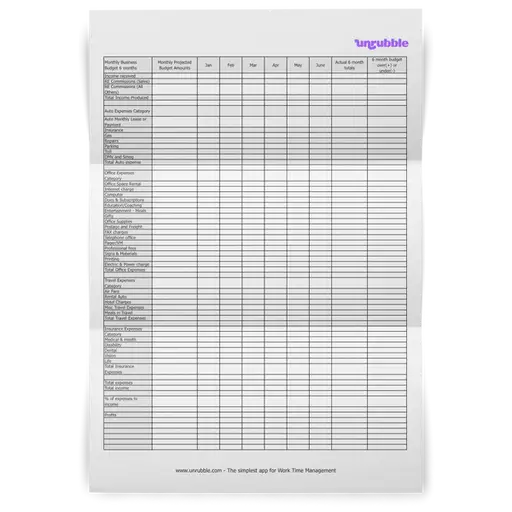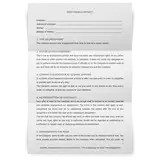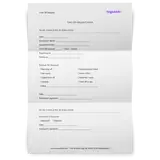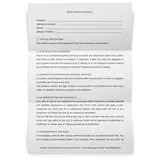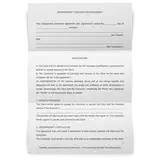Operating a business without a working budget template might just be one of the definitions of flying blind. When you don't budget properly, you may have trouble staying above your bottom line, and your profits may even sink. With this budget template, the good news is you save yourself the hassle of creating one from scratch. You'll be able to quickly position your enterprise for a smooth and controlled cash flow pattern that helps you meet your financial goals.
Here’s a sample Budget template that can be easily customized and adapted to meet your requirements. It’s free to download and use.
Why is a budget template critical?
A budget template is a powerful tool that allows business owners or management to control their cash flow instead of the other way round. It lays down the track to follow if you want to meet your long term and short term financial plan. Without the guideline of a budget template, it's a shot in the dark whether the business performs well. By tracking business income and expenditure, you'll be able to do the following, in a nutshell:
- Direct cash flow where you can get the most returns
- Cut off unnecessary expenses and costs
- Define and meet profit goals
- Track income, expenses, and cash flow
- Prepare for business upturns and downturns
- Plan for purchasing requirements
- Assess any positive or negative impacts of budget adjustments
- Gain insight into the financial health of your business
- Make projections for expansion costs, operational expenses, and income needed to stay afloat
How to do a budget
It's not an exaggeration when you hear people saying that every penny counts. Suppose you fail to adequately plan and track where all your money is going. In that case, you are definitely missing a valuable opportunity to cut costs and allocate your cash where it will make the most significant impact on your business. Crafting a budget is the only way to check whether you are spending money like you are supposed to.
Before we look at how you can make a budget for your business, let's look at what makes a proper budget. A reasonable budget has to be flexible and straightforward. If anything changes within your business, you should be able to quickly adjust your budget to fit whatever is happening.
All adequate budgets should cover the following areas:
Your business' estimated revenue
This covers the money that you expect to get from the services you provide or the goods you sell. It is the money that comes into your business without considering how much you spent to get it in. This should be the first line of your budget. If you are just starting your business, you can use industry averages for this section.
Fixed costs
This includes all your regular costs, and they don't vary no matter how much you make. They have things such as rentals, banking fees, accounting services, legal expenses and utilities.
Variable costs
As the name suggests, these costs change from time to time due to varying sales and production volumes. They are, therefore, in a way related to the cost of goods sold. They encompass anything linked to the production or purchasing of the products sold by your business. This can either be raw materials, production cost, packaging and shipping or credit card fees. Other variable costs you can enter are sales commissions and travel expenses. A reasonable and practical budget will outline all that you expect to spend on such expenses.
The money that your business spends on salaries might also fall within variable costs. For instance, your in-house team usually falls under fixed business costs, but you can, from time to time, hire or outsource temporarily, and this will fall under variable costs. It is therefore essential to ensure that you file the different types of salaries correctly.
Once-off costs
These costs are not regular, and they fall outside what your business usually spends. These include startup costs, and software purchases, research costs and moving costs.
Your cash flow
Cash flow involves all the money that enters and leaves your business. If there is more money that comes into your business than the money that's leaving, it, therefore, means that you have a positive cash flow. A simple way to do this is to calculate the difference between the money you had at the beginning of a period of time and the money you had at the end. For instance, you can calculate what you had on the first of a month and the money available on the last day of the month.
It is essential to monitor the cash flow of your business. Money is the oxygen of any business. Therefore it is crucial to know whether or not you are losing it or gaining it. There are times when it might seem like you are making a lot of money, but then you find out that you can't even cover your operational costs.
Your profit
When it comes to budgeting, this is the area you should be very concerned about. Your profit is the money you take home when all your expenses have been removed from the available revenue. If you keep having more and more profit, it means that your business is growing, and the opposite is true. Within your budget's profit section, you plan how much profit you intend to make using your expenses and projected revenue.
How does a budget template work?
You'll find all sorts of budget template examples, but they usually have the same basic format. A typical template allows you to break down your income, expenses, and cash flow to show where there's leftover capital. Some sample budget templates are tabulated yearly, so you can fill in the necessary information as each month goes by.
Generally, each monthly template contains the same details. Therefore, a single monthly template works just as well. Most importantly, every budget template should show you at any given time, whether there is enough cash for capital expenses or improvements.
Depending on how your business is run, sometimes it is necessary to include the various kinds of income or expenses. On the income section, you can split the areas into operating income, rental income and types you may use. In the expenses section, you can then use subscription expenses, dues, rentals, maintenance, marketing and repairs, among others.
Implementing a proper business budget is essential for the success and profitability of any business. When you draft a sample budget template, ensure that it covers content like revenue forecast, cost estimation. It should also leave a small window for some profits. You can check out our free budget template example to get a better idea of where to start creating your own budget.
Bottom line
Ask any business owner to define a budget, and they will probably respond by telling you a textbook definition of a budget, including words like financial plan, revenue and expenses. Ask them if they use one, and it’s a different story altogether. The truth of the matter is, many business owners do not fully understand the importance of a budget. It is the single most crucial aspect of any business, and it serves as a roadmap for companies to ensure that they are on track financially. As shown in this article, a budget doesn’t have to be complicated and hard to understand.
A business that will not budget sets itself up for a lot of financial problems. This is true for all businesses of all kinds and sizes. Conversely, a business that outlines its budget clearly creates a solid road map for financial success and serious profits.
